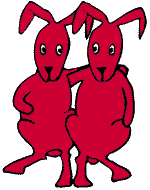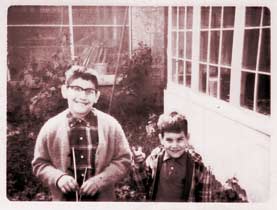home

|
|
||||||||||||||||||||||||||||||||||||||||||
|
This is a small company started by two brothers. Neil Levine is an artist, illustrator and fashion designer, living in San Francisco, California. Rick Levine is a web designer and software architect for Sun Microsystems' Java Software Division, living in Boulder, Colorado.
|
||||||||||||||||||||||||||||||||||||||||||
|
Hat Factory was born of necessity and curiosity. Neil Levine spent the last several years designing and selling hats. The hats ranged from whimsical, fun-to-wear fleece creations to stunning, high-style fashion commissions. He was searching for a way to expand distribution channels for his work, and still retain creative control.
Rick Levine created some of Sun's most successful web offerings, and has been instrumental in helping Sun to use the web and the 'net to support and run its business. However, he was concerned that it was becoming increasingly difficult to innovate in the corporate web development environment. The size and complexity of corporate web organizations work against rapid innovation and, in some organizations, damp the multi-disciplinary collaboration required to explore new vehicles for business on the web. Rick wondered, a bit idly, how hard it would be to build a small, self-contained commerce site "from the ground up" as a stage to try out new e-commerce ideas. Rick and Neil compared notes. They realized they had a product that might be sold effectively on the web, some interesting ideas about e-selling that weren't being implemented elsewhere, and the basic skills they needed to cover the expensive parts of site development. They pooled their lunch money, and started Hat Factory.
|
||||||||||||||||||||||||||||||||||||||||||
|
Red Rabbit's Fleece Hats Hat Factory was created as a showcase for hats that are as much wearable art as they are functional headgear. The fleece line was born when designer Neil Levine started experimenting with fleece, not to jump on the fleece bandwagon, but because fleece is a fabric that lends itself to describing a variety of sculptural forms and functions beautifully, as a warm and breathable garment. At Hat Factory, we want you to stay warm and still be able to express your inner child: run around, have fun, be big. (However, we do try to have something for all tastes, even for those of you who don't want to be the center of attention!) At the heart of our company is the desire to help people be comfortable, have fun and connect with each other. Lapin Rouge Couture Hats There are periods in the history of fashion where hats were a much more important element in people's wardrobes than they are today. Our designs hark back to those times. Hats are an expression of personality and character, an opportunity to stand out in a crowd. In our couture high style line, to be premiered in the spring of 1999, we meld classic sculptural forms with subtle, contrasting combinations of fabric in many textures and colors. We want these hats to ooze elegance and stop traffic simultaneously. Manufacturing Hatfactory is a small company. Neil does the hat design, pattern drafting, and prototyping, and supervises hat construction. All our manufacturing is done in the US, currently in California, by a small, skilled group of cottage industry artisans and small soft-goods manufacturers. We are committed to paying a living wage to those who do work for us and are dedicated to support ethical business practices with our vendors as well as our customers. Our motives go beyond making a profit: we want to make a positive difference in peoples' lives. Two years of consistently successful vendor relationships and many repeat customers testify that this philosophy works. Quality Our hats are built to last. We will not compromise the quality of our products. Our commitment to quality is made real in our guarantee: no questions, no time limit, no excuses. If we wouldn't send it to our mother we're not going to send it to you. And believe us when we say our mother is pretty picky when it comes to quality!
|
||||||||||||||||||||||||||||||||||||||||||
|
www.hatfactory.com was created not only to sell a retail product line, but as a test-bed for experimentation with the basic fabric and tools of the consumer e-commerce experience. Here, we offer a "top 10" from the guidelines we formulated as we built this site.
|
||||||||||||||||||||||||||||||||||||||||||
|
This site would not have been possible without the help of a very wonderful bunch of friends and associates. In our menagerie, we have: a prominent San Francisco gallery owner, a few high-tech entrepreneurs, a deputy city attorney, an Ashiatsu master, an internationally famous choreographer, a well-known San Francisco sculptor and a big-time 'net curmudgeon. To name some names:
Catharine Clark (see the Catharine Clark Gallery online,) John William Lund, Victoria Oleson, Gale Perry, Mikel Martin, Priscilla Regalado, Edward Spencer, Will Snow, John-Peter Wilhite, Jonathan Payne, Susan Yeh, Calvin Yeh-Tinetti, Madeline Payne, Anna Lund, Katie Lallas, Ray Beldner, Peter Oleson, Peter Odum, Kim Beaudry, Jurgen Schweighart, Marc Slavin, Kevin Woo, Randy Damron, Kip Turnquist, Gary, Marlene Sinicki, Michael Kimmel, Madeline Marrow, our parents, our collective spirit guides, the powers that be, Jesus, Allah, Buddha, that God on the left with the really twisted sense of humor, The Nevada State Sanitarium for the Criminally Insane, the whole gang down at the Mary Magdalene Anti-defamation League, Chris Locke (another plug: subscribe before he does sumpin' rash: Entropy Gradient Reversals), Jerry Spiegel and Larry Miller at FGK&S, Lori and Marty at PPI, and the whole cookie-loving gang at The Sphere Information Services. And, last but far from least, Sue, David, Naomi and Sarah. Our special thanks go out to all of you: we couldn't have done it without your help. (Yeah, yeah, we know: "So sell some hats, already!")
|
||||||||||||||||||||||||||||||||||||||||||
|
Neil and Rick Levine are the principals in Levine Squared, LLC, a small consultancy with offices in San Francisco and Boulder, Colorado. Neil Seth Levine received his BS in Textile Design from the Philadelphia College of Textiles & Science in 1983. After designing apparel fabrics in New York City he moved to the Bay Area where he designed textiles for home furnishings . He has also done work in the fields of photostyling, graphic design, logo design, illustration and art direction. As a Painter, his work has been the focus of several one-man shows in the Bay Area. In 1992 he completed the Dream Theater Mural Project at 1906 Market Street. Neil has continued his studies in clothing design and construction, and currently makes his living designing hats and custom clothing for private clients. Rick Levine is web architect for the Java Software division of Sun Microsystems. He is responsible for the creation of much of the current public web interface for java.sun.com, including the Java Developer Connection, a free, registration-based site for Java Developers, currently with more than 750,000 registered members.Rick has been with Sun for more than 12 years. He started his tenure at Sun leading a group that created all the desktop software for Sun's experiments with 386-based workstations, including Sun's first on-line help and easy-to-use system installation and management software. He spear-headed the creation of Sun's first usability testing facilities, and pioneered the integration of human-factors design, usability and visual language disciplines into Sun's engineering universe. Rick has been a member of several teams that worked on reinventing and redesigning Sun's external web presence. He joined the Java group in mid-1996, served a stint as webmaster of java.sun.com, and has focused his efforts on driving the creation of web delivery channels that serve both the business needs of the organization and Sun's customers. Recently, Rick was one of the authors of the Information and Content Exchange (ICE) specification, and is Sun's representative on the ICE authoring group. Rick is the author of the Sun Guide to Web Style. Prior to joining Sun, Rick worked for Control Data's PLATO system group, NCR COMTEN, various smaller companies, and, in ancient pre-history, did a lot of innovative and sometimes just-plain-off-the-wall film, video and videodisk production. |
||||||||||||||||||||||||||||||||||||||||||
about our company
![]() sizing
sizing
![]() ordering instructions
ordering instructions
![]() shipping
shipping
![]() guarantee
guarantee
Our privacy policy. What we do with your information.
Wanna talk? Send us email, 'phone us: +1 415 863-3878, fax us: +1 303 440-4770.This page and hat designs Copyright © 1998 Levine Squared, LLC. All rights reserved.
"Hat Factory," "Red Rabbit," "Lapin Rouge" and all other marks are trademarks of Levine Squared, LLC.

